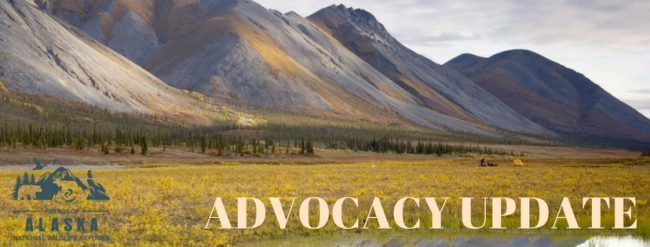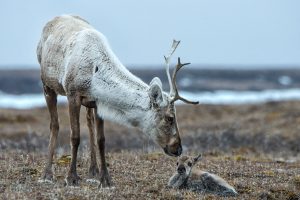FOR IMMEDIATE RELEASE
June 2, 2020
Contacts:
David Raskin, president of Friends of Alaska National Wildlife Refuges, davidc.raskin@me.com, 425-209-9009
Gwen Dobbs, director of media relations, Defenders of Wildlife, gdobbs@defenders.com, 202-329-9295
Corey Himrod, Senior Communications Manager, Alaska Wilderness League, Corey@alaskawild.org, 202-266-0426
Fran Mauer, representative of Alaska Chapter Wilderness Watch, fmauer@mosquitonet.com, 907-455-6829 or 907-978-1109
Dawnell Smith, communications director, Trustees for Alaska,
dsmith@trustees.org, 907-433-2013
Court shuts down Interior’s second illegal land deal with King Cove Corp
Ruling sustains protections for vital wetlands in Izembek and for public lands everywhere
A federal District Court decision released late yesterday resoundingly shut down the Interior Department’s second attempt at an illegal land exchange with the King Cove Corporation to make way for a road through vital protected wetlands in Izembek National Wildlife Refuge.
“For the second time, the Court has told the road proponents that invading the Izembek Wilderness and damaging the biological heart of the Refuge to build an unnecessary and expensive road is unacceptable,” said David C. Raskin, president of Friends of Alaska National Wildlife Refuges. “Let us hope that this decades-long, misguided effort is finally over, and the natural habitat and wildlife that depend on the Izembek Refuge will continue to be protected in perpetuity.”
Trustees for Alaska filed the lawsuit in January 2020 on behalf of nine groups. A court ruling in March 2019 voided Interior’s previous land swap agreement, nearly identical to the Agreement vacated by the Court yesterday. Interior appealed the court’s decision in the first lawsuit, but then entered into another unlawful land deal behind closed doors while that appeal was pending. The second land swap deal had violated the same laws as the first, but would have been even more damaging by allowing commercial use of any future road.
“The Court found that Interior broke the law again to benefit commercial interests, with no regard for the consequences to public lands, water, or wildlife,” said Bridget Psarianos, staff attorney with Trustees for Alaska. “Interior’s continued and failed attempts to dodge the laws mandating protections of our National Wildlife Refuges is an insult to the American public. We are thrilled the Court rejected this corrupt and illegal land exchange, finding that it is contrary to the purposes of Izembek and ANILCA, and that such an exchange could not be done without Congressional approval. We hope this is last time we need to ask a Court to reject such an exchange.”.”
Like the first lawsuit, the second one argued that Interior cannot use the land exchange provision of the Alaska National Interest Lands Conservation Act to gut a National Wildlife Refuge and congressionally designated wilderness. Groups also argued that Interior circumvented public process, environmental review, and congressional approval.
Commercial and private interests have advocated for a road for decades. Under the Trump Administration, Interior has made repeated attempts to push through a land swap intended to trade Refuge and Wilderness lands to make way for a road.
The Court held that Interior violated ANILCA in two ways. First, the exchange does not meet ANILCA’s conservation purposes or the specific purposes of Izembek Refuge to protect wilderness and wildlife values. The court also agreed that the Exchange Agreement is an approval of a transportation system that falls within the ambit of ANILCA Title XI. As a result, Interior could not enter this exchange without approval from Congress and the President. Finally, the Court found — as in the previous lawsuit — that the Secretary failed to provide adequate reasoning to support the change in policy in favor of a land exchange and a road through Izembek.
GROUP STATEMENTS:
“The court has seen through the Trump administration’s illegal attempt to trade away the globally-renowned wildlife habitat and congressionally-designated wilderness lands of the Izembek National Wildlife Refuge,” said Nicole Whittington-Evans, Alaska Program Director for Defenders of Wildlife. “This is a victory for an ecologically irreplaceable area and the black brant, Emperor geese, brown bears and stunning array of other wildlife that call it home.”
“The wilderness values of the Izembek Wildlife Refuge are irreplaceable. Unlawfully giving away public land to build a road right through its heart that could be used for commercial use is characteristic of this administration’s constant catering to private interests,” said Kristen Miller, Conservation Director at Alaska Wilderness League. “We applaud the court’s judgment today. Building a road through federal wilderness would have been a bad deal for taxpayers and a bad deal for the environment, especially when there are other, safer options available.”
“Once again, an illegal land trade scheme by the Trump administration to build a road across the Izembek Refuge Wilderness has been stopped by a court decision.” said Fran Mauer, Alaska Chapter of Wilderness Watch. “This decision not only protects the incomparable wildlife and wilderness of Izembek, but it also helps to preserve the integrity of the National Wilderness Preservation System from a harmful precedent.”
“Today’s court decision once again holds the administration accountable for another blatant attempt to circumvent public process and environmental review,” said Sarah Greenberger, interim chief conservation officer and senior vice president for conservation policy at National Audubon Society. “Nearly every single Pacific Brant stops over in Izembek National Wildlife Refuge during migration each year. Paving the way for a road through this Refuge would put this bird population and others at significant risk. Any attempt to skirt the law and disrupt this vital habitat will be met with our strong opposition.”
“A road through the Izembek National Wildlife Refuge would be a costly and ineffective use of taxpayer dollars, and would severely damage this important wilderness,” said Dan Ritzman, Director of the Sierra Club’s Lands Water Wildlife Campaign. “This deal has been repeatedly studied and consistently rejected for good reason, and we’re glad to see the court reject it once again.”
“Great news today. The Courts have once again protected the Izembek National Wildlife Refuge when the Administration has tried so hard to do the opposite,” says Geoffrey Haskett, President of the National Wildlife Refuge Association. “The Administration keeps trying to plow this road through this magnificent wilderness ignoring all previous decisions to protect it. The rule of law prevails and the Izembek Refuge remains protected. This is an enormous victory protecting an incredible wilderness.”
“This is an enormous victory for one of the most spectacular places on the planet,” said Randi Spivak, public lands director at the Center for Biological Diversity. “The court shot down the Trump administration’s arrogance and hubris. We’re so grateful the judge recognized that there is absolutely no basis to overturn the decades of science and study that has already been done. All of this analysis agreed that bulldozing a road through the heart of Izembek would devastate one of the world’s most ecologically significant wildlife refuges.”


 The Arctic Refuge drilling proposal and Izembek Refuge battles continue, and we expect major events in the very near future.
The Arctic Refuge drilling proposal and Izembek Refuge battles continue, and we expect major events in the very near future.
